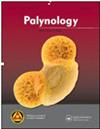Descriptive Systematics of Upper Palaeocene–Lower Eocene pollen and Spores from the Northern Niger Delta, South-Eastern Nigeria
IF 1.3
4区 地球科学
Q3 PALEONTOLOGY
引用次数: 1
Abstract
ABSTRACT Fossil pollen and spores are a vital source of information on the geological history of tropical vegetation including reconstructions of vegetation diversity and composition. However, such work relies on a sound taxonomic framework, and this is challenging to achieve because of the large number of pollen and spore morphotypes that are encountered in palynological preparations from tropical sediments. In tropical West Africa, for example, extensive taxonomic work on Cretaceous–Paleogene pollen and spores was undertaken in the later part of the twentieth century, but more recent palynological work has focussed on stratigraphy and basin evolution, and there is a need for additional taxonomic work on the pollen and spores of this region. We have undertaken a descriptive systematic study of pollen and spores (sporomorphs) from 15 sediment samples spanning the Upper Palaeocene–Lower Eocene of south-eastern Nigeria. A palynoflora consisting of 29 spores, two gymnosperm pollen grains, and 138 angiosperm pollen grains is described. Two new spore species are proposed, and one new genus and 18 new species of angiosperm pollen are proposed. The general vegetation type represented by the palynoflora consists of palm-dominated swamps, perhaps with mangroves. The richness of each sample ranges from 29 to 76 sporomorph taxa, and rarefaction analysis suggests an increase in diversity from the Palaeocene to the Eocene in this region. Samples from the Palaeocene Upper Nsukka Formation are dominated by pollen with botanical affinities to the Arecaceae (palms) and Araceae (arums), and this assemblage is very similar to the Palaeocene in the Neotropics.尼日利亚东南部尼日尔三角洲北部上古新世-下始新世花粉和孢子的描述系统
花粉和孢子化石是热带植被地质历史的重要信息来源,包括植被多样性和组成的重建。然而,这样的工作依赖于一个完善的分类框架,这是具有挑战性的,因为在热带沉积物的孢粉学准备中遇到了大量的花粉和孢子形态。例如,在热带西非,对白垩纪-古近纪花粉和孢子的广泛分类工作是在20世纪后期进行的,但最近的孢粉学工作主要集中在地层学和盆地演化上,因此需要对该地区的花粉和孢子进行额外的分类工作。我们对尼日利亚东南部上古新世-下始新世的15个沉积物样本中的花粉和孢子(孢子形)进行了描述性系统研究。描述了一个由29个孢子、2个裸子植物花粉粒和138个被子植物花粉粒组成的孢粉区系。提出了2个新的孢子种,1个新的属和18个新的被子植物花粉种。以孢粉植物群为代表的一般植被类型包括以棕榈为主的沼泽,可能还有红树林。每个样品的孢体分类丰富度在29 ~ 76个之间,稀疏分析表明该地区的孢体多样性从古新世到始新世有所增加。古新世上Nsukka组的花粉以与槟榔科(棕榈树)和天南星科(arums)植物相似的花粉为主,这种组合与新热带地区的古新世非常相似。
本文章由计算机程序翻译,如有差异,请以英文原文为准。
求助全文
约1分钟内获得全文
求助全文
来源期刊

Palynology
地学-古生物学
CiteScore
3.40
自引率
26.70%
发文量
48
审稿时长
>12 weeks
期刊介绍:
Palynology is an international journal, and covers all aspects of the science. We accept papers on both pre-Quaternary and Quaternary palynology and palaeobotany. Contributions on novel uses of palynology, review articles, book reviews, taxonomic studies and papers on methodology are all actively encouraged.
 求助内容:
求助内容: 应助结果提醒方式:
应助结果提醒方式:


